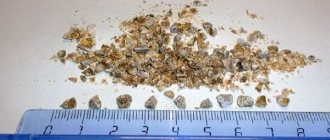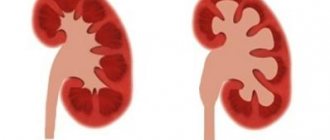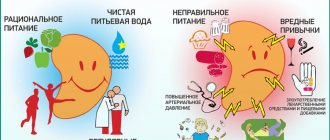Home / Other
Back
Published: 10/01/2020
Reading time: 12 min
0
595
- Causes of sand in the kidneys
- Risk factors
- Symptoms Why does pain occur?
- Signs in men
- Symptoms in women Sand in the kidneys - symptoms during pregnancy
- How many days does it take for sand to leave the kidney?
- Tests for sand in the kidneys
- How to dock?
- Kidney cleansing
- Video: how to prevent urolithiasis
Causes of sand in the kidneys
Scientists have not yet studied the reasons for the formation of sand in the kidneys. It is believed that this is due to a metabolic disorder in the body, as well as a urinary tract infection.
Other factors influencing the formation of sand in the kidneys are:
- hereditary predisposition to the occurrence of uric acid diathesis;
- dysfunction of the hormonal system associated with thyroid diseases;
- chronic diseases of the urinary system;
- lack or excess of calcium;
- prostate adenoma, in which the outflow of urine is disrupted;
- physiological characteristics of the urinary tract;
- abuse of alcoholic beverages, fatty and salty foods;
- passive lifestyle.
In addition, for normal metabolism and the functioning of the body’s vital systems, it is necessary to observe the correct drinking regime - drink up to two liters of clean water per day. But often it is replaced by juices, tea and other drinks that are unable to maintain the exchange of water and salts at a normal level. Using ordinary tap water for cooking, which has increased hardness, also risks the appearance of sand in the kidneys.
Risk factors
People whose work activities take place in drafts and cold rooms are at risk. Working in chemical plants producing aniline dyes and pesticides can cause kidney disease due to the nephrotoxic effects of the chemicals.
Another risk factor is the type of activity associated with injury. Professional sports, in particular martial arts (boxing, Thai boxing, karate) can cause kidney disease due to aggressive mechanical influence.
Excess weight and obesity increase the risk of urolithiasis due to a wide range of metabolic disorders (with diabetes or gout, under-oxidized metabolic products accumulate, the pH shifts to the slightly acidic side, and acidic urine salts appear).
A history of kidney disease, such as pyelonephritis or glomerulonephritis, significantly increases the risk of developing kidney disease even after 10 years. Sand in the kidneys and pyelonephritis may indicate an acute inflammatory process due to bacterial infection, as well as Candida fungi.
Methods of therapy
The treatment regimen for sand in the kidneys and the choice of drugs is carried out by the attending physician individually for each patient, depending on the diameter of the formation, its composition and the general condition of the patient.
The goal of treatment is to crush large lumps and remove them naturally. For this purpose, mixtures, solutions and capsules are used. Tablets are used to expel sand particles whose size does not exceed 4 mm.
Complex therapy includes the following groups of drugs:
- Diuretics . Prevents the accumulation of sand particles.
- Anti-inflammatory . They prevent cystitis and urethritis from developing. They have an enveloping and softening effect. Protect internal surfaces damaged as a result of the release of kidney formations from all kinds of infections.
- Relaxing . Promote the normal passage of particles through the ureter.
- Absorbable . Which can completely remove all the sand.
- Restoring kidney function . They will restore organs to function properly.
Only a doctor can prescribe this or that type of medication. Self-medication is categorically unacceptable; it will only aggravate the situation and lead to undesirable consequences.
Traditional treatment
Typically, your doctor prescribes the following medications:
- Canephron, Cystenal, Enatin, Avisan, Marelin, Uralit - dissolve stones;
- Phytosilin. Envelops - relieves inflammation;
- Fitolit, Olimethin, No-shpa, Spasmonet, Urolesan - push particles through , promote their removal and relax;
- Spazgan, Spazmalgon, Urolesan - relieve pain if the ureter is blocked;
- Nise - relieves inflammation and swelling .
Folk remedies
Traditional medicine offers effective recipes, but they must be used comprehensively. It is known that the chemical composition of renal formations is not the same; there are several varieties:
- oxalate, oxalic acid predominates;
- phosphate, from phosphorus-potassium, coal salts, the most common type;
- urate, based on uric acid salts, the cause is disorders of the digestive system.
Depending on this characteristic, one or another herbal collection is used. Before making infusions, decoctions, herbs are thoroughly dried. It is also necessary to take into account the fact that the course of herbal medicine cannot last longer than the prescribed period; skipping the preparations is also not recommended; it is advisable to do this before meals according to the instructions.
For oxalates and phosphates
Decoctions are prepared from the following ingredients:
- peppermint;
- rosehip;
- motherwort;
- dill seeds;
- St. John's wort;
- lingonberry leaves;
- chicory;
- hop cones;
- immortelle.
With urates
Effective:
- corn silk;
- Birch buds;
- dog-rose fruit;
- mint leaves;
- Dill seeds;
- knotweed
The chemical composition of sedimentary substances is also taken into account in cases where it is necessary to organize proper nutrition. What diet should you follow if you have kidney stones or sand?
Symptoms
In the initial stage of development, the disease rarely manifests itself with pronounced symptoms. But if not detected in a timely manner, sand in the kidneys can turn into stones larger than 3 mm in size, which will make itself felt with obvious manifestations.
Typical symptoms of coarse sand coming out of the kidneys in men and women are as follows.
- When solid inclusions move through the urinary tract, mechanical irritation of the mucous membranes occurs, which leads to inflammation. What sensations do you experience when coarse sand comes out of your kidneys? A person feels aching or sharp pain in the lower back. It is usually localized on one side of the back, in the area of the right kidney. As the disease progresses, pain can spread to the groin and upper abdomen.
- The next symptom of sand and kidney stones is problematic urination. It becomes very painful, and you have to resort to it often. At the same time, the urge does not always end with the passage of urine.
- How can you tell if sand is coming out of your kidneys? Physical indicators of urine should alert you. It becomes cloudy, dark, and in some cases acquires a sharp, unpleasant odor. Sometimes minor inclusions of blood appear, and in advanced cases even purulent clots.
How to determine the presence of coarse sand and kidney stones? An increase in general temperature (this indicates the development of an inflammatory process), nausea, similar to poisoning, often turning into vomiting, as well as general weakness and insomnia are atypical symptoms.
Additional symptoms when coarse sand and stones come out of the kidneys in women bearing a child are increased swelling, increased pressure and a more pronounced nature of the main signs of urolithiasis.
Why does pain occur?
The moment grains of sand begin to move through the urinary tract, the mucous membranes begin to be injured. The nerve receptor, which is located on the epithelial ball, constantly remembers information about damage, and then sends a signal to the brain about it. Such messages to the cerebral cortex are regarded as a pain signal, and the patient notes their exact location: lower back, pubic part, urethra.
Signs in men
Since the anatomical structure of men has its own characteristics, when sand comes out of the kidneys, patients are concerned about the following signs:
- pain in the groin area;
- discomfort and pain in the penis area.
Severe pain is a concern if stones come out of the kidneys. If the sand particles are large, they can cause damage to the mucous surface of the ureters.
As a result, blood and mucus clots will appear in the urine - this can also be classified as specific symptoms.
When sand leaves the kidneys, male patients note the following sensations:
- a bursting feeling in the penis area;
- pain, burning, discomfort when urinating;
- feeling of incomplete emptying of the bladder.
If timely measures are not taken, problems can lead to the development of a serious illness.
Symptoms in women
If we take into account the anatomical features of the female body, then as specific symptoms we can note the presence of:
- pain in the lower abdomen;
- discomfort and burning when urinating.
Diagnostics
Sand in the kidneys can be preliminarily determined at home, but to confirm the diagnosis, a full examination with tests and hardware procedures is necessary. Indicators for visiting a doctor are the presence of symptoms (in both men and women).
Determination at home
A clear sign of the presence of sand in the kidneys is a change in the color of the urine and its cloudiness. To carry out diagnostics at home, you will need a transparent sterile container.
Next you need:
- Carry out hygiene procedures. If you are menstruating, place a cotton swab in your vagina.
- Urinate into the prepared container.
- Normally, urine has a transparent straw-yellow color, without a pungent odor. If the smell is strong and foreign particles are present, this may indicate the presence of sand in the kidneys.
- Leave the container with urine for 30-60 minutes. If the suspension in urine settles to the bottom. The probability of confirming the diagnosis is 90%.
The day before the procedure, it is not recommended to consume spicy, salty and fatty foods, as well as certain types of medications (which affect the color of urine and quality).
Diagnosis of pathology in the hospital
The examination for diagnosing sand in the kidneys consists of 3 main stages, which are discussed below.
Visual examination and history taking
At this stage, the specialist identifies:
- the presence of a hereditary predisposition to the disease;
- existing chronic diseases;
- what symptoms are present and approximately when they began;
- what diseases have been suffered recently;
- what medications are taken;
- temperature and pressure indicators are measured.
By palpation, diseases with similar symptoms (cystitis, intestinal obstruction, osteochondrosis) are excluded. An examination by a gynecologist may be required to rule out pathologies in the reproductive organs.
Laboratory research
To confirm or refute the diagnosis, a general and biochemical urine and blood test is sufficient. A blood test determines the patient’s general condition and excludes infectious diseases.
Urine examination is carried out according to the following indicators:
| Parameters studied | Description of results |
| Urine environment | Normally, the pH of urine should be in the range from 4 to 7. A deviation in the value may indicate the presence of sand or a predisposition to its formation. |
| Protein and leukocytes | The presence of protein and leukocytes is characteristic of the presence of inflammatory processes in the body, which can be caused not only by sand, but also by other pathologies. |
| Blood | Blood in the urine means damage to the capillaries in the urinary system. It is a characteristic sign of sand in the kidneys. Sometimes it can be a side effect of taking medications. |
| Color | Any deviation from the straw-yellow color is characterized by the presence of pathologies in the urinary system. Also, the color may change from taking medications or eating coloring products (vitamins, beets, carrots). |
| Transparency | Turbidity may indicate the presence of sand, white blood cells or pus, which is typical for sand in the kidneys. |
| Bacteria | Indicate the presence of infection in the urinary system. It can also confirm pathology. |
| Presence of sediment | It is the most important parameter to confirm the diagnosis. The study examines the composition of the sediment. |
The results of laboratory tests can be obtained in 3-5 hours.
Hardware diagnostics
To determine the condition of the kidneys and the number of formations in them, an additional examination is prescribed using the following devices:
- Ultrasound. The method allows you to assess the size and condition of the kidneys, as well as identify sand if the “grains” are not too small;
- Radiography. Confirms the presence of sand with particles of any size and monitors whether formations are removed from the kidneys or not;
- Urography. Detects sand even at the initial stage of pathology development;
- Nephroscintigraphy. Allows you not only to identify sand and its quantity, but also to determine particle sizes.
According to laboratory and hardware tests, a specialist can not only confirm the pathology, but also determine the advanced stage of the disease.
When to call an ambulance
If sand leaves the body in urine, severe pain does not occur. A significant deterioration in health - fever, pain when urinating, acute pain in the lower back - indicates blockage of the urinary tract, inflammation of the kidneys or urinary tract.
It is recommended to call a doctor at home if:
- blood is found in the urine;
- pain from the lower back spreads to the perineum;
- chills occur;
- cold sweat breaks out.
Colic is a clear sign of stone formation. Patients constantly change body position to reduce pain.
What to do before the doctor arrives:
- place the patient in a hot bath;
- give non-narcotic analgesics and antispasmodics - No-shpu, Ketanov, Ibuklin, Spazmalgon;
- apply a heating pad to your lower back.
Heat therapy is the main way to combat renal colic. It is not suitable only for infectious inflammation of the urinary system.
Diet
If there is sand in the kidneys, a strict diet is recommended, the nature of which will depend on what type of salt predominates in the secretions. If these are urates, then it is necessary to limit the consumption of meat products, especially smoked and fried ones. Also, the food should not contain pepper, coffee, cocoa, chocolate, meat broths, alcohol and legumes.
If oxalates (oxalic acid salts) predominate in the urine, you should limit your consumption of chocolate, coffee, salads, strawberries, dairy products and citrus fruits.
If the bulk consists of phosphorus and calcium salts, fish, cheese, cottage cheese and seafood should be excluded from the diet. A mandatory procedure is to consume about two liters of fluid daily.
Features of urolithiasis
Before using folk remedies for sand and kidney stones, it is necessary to find out what type of tumor it is. Without a general urine test, you should not start treatment, as it may not work or even be harmful.
Based on the type of salts, the following types of deposits are distinguished:
- urates, formed from salts of uric acid;
- oxalate, which are derivatives of oxalic acid;
- phosphate.
With an increase in the content of a certain type of salts in the urine, the risk of formation of sand in the kidneys, first, and, over time, stones of this type increases.
How many days does it take for sand to leave the kidney?
If you periodically undergo examination by doctors, you can notice how sand begins to migrate along the urinary tract.
It is not possible to determine the exact time when sand leaves the kidney. This process is influenced by various factors: what gender the patient is, how old he is, whether there is a tendency to urolithiasis. To speed up the process, the patient drinks a lot of fluids and excludes salty, fatty foods, legumes and processed foods. On average, the process of sand removal is 9-30 days; in particularly difficult cases, the process lasts longer.
Prevention
After treatment and removal of sand from the kidneys, simple rules must be followed to avoid relapses. The first step is to identify the cause of the metabolic disorder and eliminate this cause. Simple recommendations must be followed:
- adhere to a diet with limited salt intake;
- drink large amounts of water;
- give up alcoholic beverages and tobacco products;
- take complex vitamins every six months;
- visit your doctor regularly.
Give up alcohol and tobacco
How does the release of stone formation salts occur during urolithiasis?
At present, it is quite difficult to describe what it feels like when sand comes out of a patient’s kidneys, because the manifestations of urolithiasis in each individual patient have their own individual characteristics.
It is important! The greatest predisposition to salt deposition is observed in pregnant women, against the background of changes in metabolic processes and hormonal levels.
The most common signs of sand coming out of the kidneys:
- At the very initial stages, during the movement of sand to the outlet of the urinary tract, significant irritation of the mucous membranes is observed and an inflammatory process occurs;
- The presence of painful urination - when sand moves through the urinary tract, cutting pain occurs, which complicates the normal outflow of urine;
- Presence of acute pain in the lumbar region;
- Changes in the composition and color of urine - with urolithiasis, the urine becomes cloudy, dark, sometimes with admixtures of blood; if we talk about color, it depends on the chemical composition of the formations, with all this, the presence of pus in the urine indicates an advanced disease.
How long does sand come out of the kidneys? Unfortunately, today it is almost impossible to give an exact answer to this question, since this process is influenced by a number of factors, for example:
- patient's age;
- composition and quantity of solid elements;
- individual characteristics of the body.
The sand release process may take some time, but in general everything is strictly individual.
It is important! In order to understand how sand comes out of the kidneys, you need to highlight the most effective methods of dissolving stones - drinking plenty of fluids, diuretic infusions and decoctions, performing special physical exercises and following a diet that directly depends on the chemical composition of the stones.
Basic recommendations during the passage of sand and solid elements from the urinary system
In order to get a clear and comprehensive answer to the question of what should be done when sand comes out of the kidneys, you need to immediately seek help from a qualified urologist, who, having studied all the medical history data and based on the examinations performed, will prescribe comprehensive individual supportive treatment.
Today on the pharmaceutical market there is a huge selection of special medications that can dissolve and remove small and large stones, salts and sand from the kidneys, and they also have a positive effect on the processes of functional restoration of the urinary system.
For the purpose of prevention, adherence to a diet is of great importance, which implies the complete exclusion of absolutely all foods that provoke urolithiasis.
It is important! This article provides reference information only; under no circumstances should you self-medicate, and before using any medicine or traditional medicine method, be sure to get permission from your doctor! Take care of yourself!
The kidneys perform a filtration function; they help rid the body of waste products and toxic substances.
But since the organs have a porous structure, salts settle in them, gradually turning into sand, and the sand into stones.
The release of sand from the kidneys is accompanied by unpleasant sensations.
How to dock?
To eliminate pain due to the release of sand from the kidneys, standard antispasmodics are suitable.
Pain may appear in the lower back, groin and external genitalia. You should not try to stop the discomfort caused by yourself, but it is better to seek medical help. It is allowed to take “No-shpa”, “Baralgin” or “Atropine” before the doctor arrives, this will help normalize the patient’s condition. If pain intensifies or there is blood in the urine, take 1 tablet of “Panangin” and “Vitamin B6”. They will help absorb magnesium. Spasms are relieved by 1-2 Spazmalgon tablets.
Possible complications
If a patient does not consult a doctor for help in a timely manner, complications arise that are associated with damage to the organs of the urinary system:
- Chronic pyelonephritis is a constantly recurrent inflammation of the renal pelvis of infectious etiology, which leads to kidney dysfunction.
- Acute obstructive pyelonephritis - blockage of the urinary tract with a stone occurs, which disrupts the flow of urine and creates a favorable environment for the proliferation of various bacteria, which can subsequently enter the blood with toxins and cause shock in the patient.
- Pyonephrosis or purulent kidney - urgently needs to be removed surgically.
- Purulent paranephritis is inflammation of the tissue surrounding the kidney.
- Nephrosclerosis is the replacement of renal functional tissue with connective tissue.
- Chronic renal failure is kidney dysfunction.
- Acute renal failure - observed when two or only kidneys fail.
A man who has a tendency to develop sand and stones should contact his doctor or the nearest clinic for medical assistance in case of pain on the right or left side, as well as in the presence of red urine.
Symptoms indicating kidney pressure
- Weakening the effect of antihypertensive drugs . The medications that patients previously took for blood pressure stop working.
- Nocturia is an increase in urine production at night. Sometimes patients get up to go to the toilet several times a night. Lack of proper sleep leads to headaches and heart problems.
- Swelling that appears in the morning . At the beginning of the disease, swelling decreases during the day or even disappears completely. When kidney function deteriorates, this condition persists permanently. Renal edema is loose, so after pressing with a finger, a hole remains that does not disappear for a long time. Fluid excretion worsens after consuming salty, smoked and alcoholic foods.
- Decreased amount of urine excreted . Patients feel a false urge that is not accompanied by urination.
If measures are not taken, renal failure will develop, which will “tie” the patient to a hemodialysis machine (artificial kidney).
Treatment of the disease
It doesn’t matter whether men have sand in their kidneys or women, treatment occurs using several methods. In medical practice the following are used:
| Diet | Depends on the type of abrasive:
|
| Pharmacological drugs | Prescribed if sediment appears due to infection. These are mainly antibiotic drugs. After this, in order to stimulate the removal of sand, a complex of plant-based diuretics + anti-inflammatory drugs is prescribed (to prevent urethritis and cystitis from appearing). |
| Surgery | Surgery is necessary when there are large accumulations of sand or large and multiple stones. The drugs will not have the desired effect, it is difficult to break up a large amount using the wave method, and the release of these formations will bring a lot of discomfort to the patient. |
| Lithotripsy | This technique is used when there are small accumulations of sand and small stones. They are crushed by shock waves, after which they are naturally excreted in the urine. |
The treatment method depends on the amount of sand and the size of the grains. The diet is more preventative and supportive, but the main treatment is taking medications, surgery or lithotripsy.
Preventing the appearance of sand in the kidneys
Preventive measures to prevent the formation of sand in the kidneys are advisory in nature and are aimed at adjusting lifestyle.
First of all, you need to start playing sports. It doesn’t have to be professional, active morning exercises and walking every day will be enough. It is also necessary to regularly use diuretics of natural origin: watermelon, cranberry juice, rosehip decoction. It is not advisable to restrain the urge to urinate by force. This leads to stagnation of urine and accumulation of salts in the kidneys.
Excessive alcohol consumption should be avoided, and calcium supplements should be taken in strictly prescribed dosages.
You can prevent the formation of sand and kidney stones if you follow a drinking and nutritional regime and do not get carried away with bad habits. With the appearance of symptoms indicating the appearance of pathology (back pain near the lower back, painful urination, changes in the physical properties of urine), you must go to the hospital for examination.
In conclusion, let us recall that sand up to 2 mm in size most often comes out in the urine on its own, without causing any special sensations. And if stones larger than 3 mm form, you must consult a doctor for professional medical care. It must be remembered that even folk remedies must be used only with the permission of a doctor and under his supervision.
Video: how to prevent urolithiasis
Sand in the kidneys is a common disease in men, which may not manifest itself for a long time. But being the first stage in the development of urolithiasis, this condition requires immediate treatment, the basis of which is lifestyle correction and supportive drug therapy if necessary.







